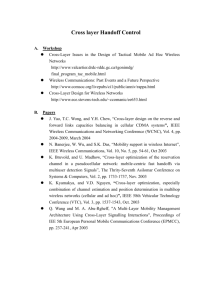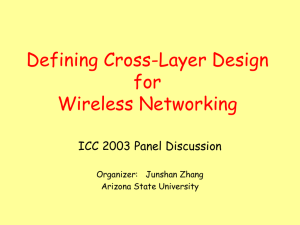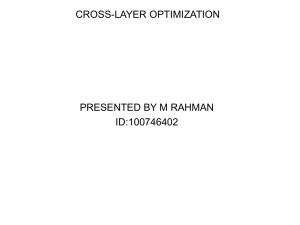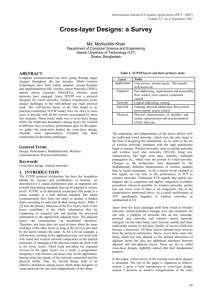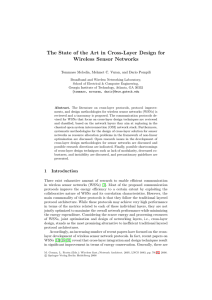6 Cognitive Radio Node Prototype
advertisement
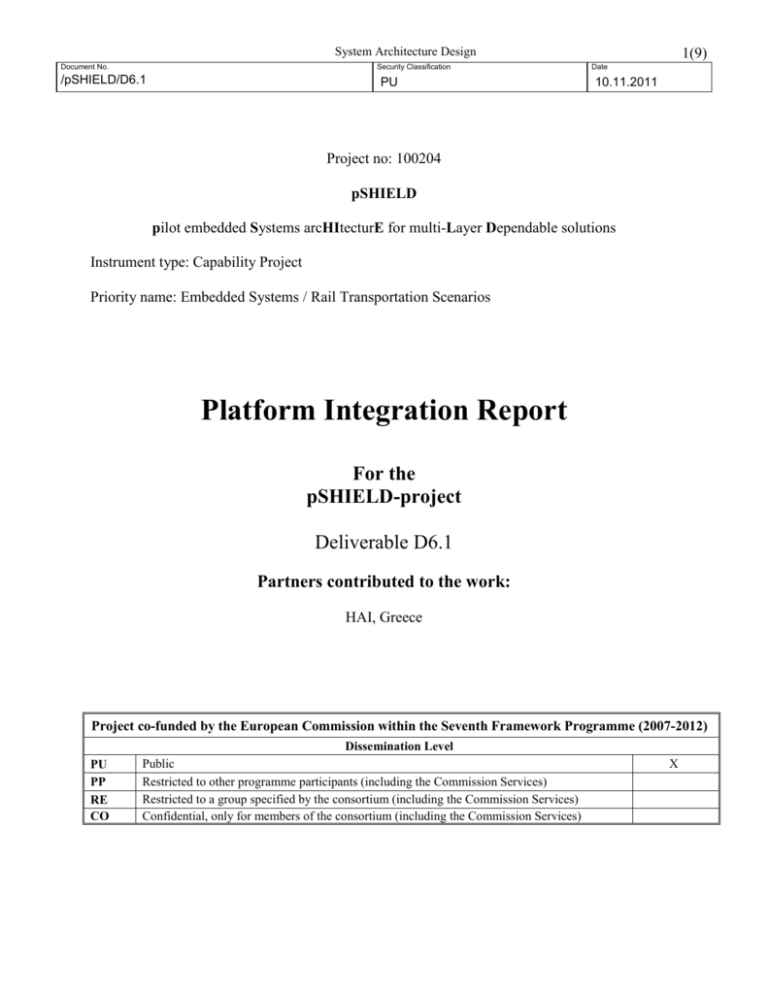
System Architecture Design Document No. Security Classification /pSHIELD/D6.1 PU 1(9) Date 10.11.2011 Project no: 100204 pSHIELD pilot embedded Systems arcHItecturE for multi-Layer Dependable solutions Instrument type: Capability Project Priority name: Embedded Systems / Rail Transportation Scenarios Platform Integration Report For the pSHIELD-project Deliverable D6.1 Partners contributed to the work: HAI, Greece Project co-funded by the European Commission within the Seventh Framework Programme (2007-2012) Dissemination Level PU PP RE CO Public Restricted to other programme participants (including the Commission Services) Restricted to a group specified by the consortium (including the Commission Services) Confidential, only for members of the consortium (including the Commission Services) X System Architecture Design Document No. 2(9) Security Classification /pSHIELD/D6.1 Date PU 10.11.2011 Document Authors and Approvals Authors Name Company Nikos Pappas HAI Date Reviewed by Name Company Approved by Name Company Modification History Issue Draft A Issue 1 Issue 2 Issue 3 Issue 4 Issue 5 Issue 6 Issue 7 Date Description 10.11.2011 First issue for comments, Table of Contents Signature System Architecture Design Document No. Security Classification /pSHIELD/D6.1 PU 3(9) Date 10.11.2011 Contents 1 Executive Summary ................................................................... 5 2 Introduction ................................................................................ 7 3 pSHIELD Platform Structure ...................................................... 7 3.1 ............................................................................................................7 3.1.1 3.1.1.1 ....... ........................................................................................................7 ........ ...................................................................................................... 7 4 Monitoring Trains with WSNs .................................................... 7 5 FPGA Power Node Prototype .................................................... 7 6 Cognitive Radio Node Prototype ............................................... 7 7 Composability Middleware Prototype ....................................... 7 8 Conclusion .................................................................................. 7 9 References .................................................................................. 8 Figures No table of figures entries found. Tables No table of figures entries found. Glossary AES BSS CCK CCMP CDMA CLA CPU Advanced Encryption Standard Basic Service Set Complementary Code Keying Counter mode with Cipher block chaining MAC Protocol Code Division Multiple Access Cross Layer Architecture Central Processing Unit System Architecture Design Document No. Security Classification /pSHIELD/D6.1 CR CSMA/CD DDR3 DPRAM DRA DRAM DSP DSSS DVB-RCS EAP EAP-TLS EAP-TTLS ESD ESs FDMA FCC FHSS FPGA FSK I/O JVM LAN LDAP NGN OFDM OS PC PEAP pS-ESD pS-MS pS-OS pS-P pS-P pS-SPD-ESD PSK QoS RAM RF SDR SDRAM SIP SNMP SPI SOA SPD SSL TDMA PU Cognitive Radio Carrier Sense Multiple Access with Collision Detection Double-Data-Rate Dual Ported RAM Dynamic Resource Allocation Dynamic RAM Digital Signal Processor Direct-Sequence Spread Spectrum Digital Video Broadcasting Return Channel via Satellite Extensible Authentication Protocol EAP-Transport Layer Security EAP-Tunneled Transport Layer Security Embedded System Device Embedded Systems Frequency Division Multiple Access Federal Communications Commission Frequency-Hopping Spread Spectrum Field-programmable Gate Array Frequency-Shift Keying Input/Output Java Virtual Machine Local Area Network Lightweight Directory Access Protocol Next Generation Network Orthogonal Frequency-Division Multiplexing Operating System Personal Computer Protected EAP pSHIELD Embedded System Device pSHIELD Middleware Service pSHIELD Overlay Service pSHIELD Subsystem pSHIELD Proxy SPD Embedded System Device Phase-Shift Keying Quality of Service Random Access Memory Radio Frequency Software Defined Radio Synchronous Dynamic RAM Session Initiation Protocol Simple Network Management Protocol Serial Peripheral Interface Service Oriented Architecture Security Privacy Dependability Secure Socket Layer Time Division Multiple Access 4(9) Date 10.11.2011 System Architecture Design Document No. Security Classification /pSHIELD/D6.1 TKIP TPM UART UCS USB VPN WEP WLAN WPA WPAN WRAN 1 PU Temporal Key Integrity Protocol Trusted Platform Module Universal Asynchronous Receiver/Transmitter Use case Scenario Universal Serial Bus Virtual Private Network Wired Equivalent Privacy Wireless Local Area Network Wi-Fi Protected Access Wireless Personal Area Network Wireless Regional Area Network Executive Summary D6.1 is a deliverable inside pSHIELD WP6, “Multi-Technology System Developments. 5(9) Date 10.11.2011 System Architecture Design Document No. /pSHIELD/D6.1 Security Classification PU 6(9) Date 10.11.2011 System Architecture Design Document No. Security Classification /pSHIELD/D6.1 2 PU 7(9) Date 10.11.2011 Introduction The main goal of pSHIELD is to ensure that security, privacy and dependability (SPD) in the context of integrated and interoperating heterogeneous services, applications, systems and devices. Systems and services must be robust in the sense that an acceptable level of services is available despite the occurrence of transient and permanent perturbations such as hardware faults, design faults, imprecise specifications, and accidental operational faults. 3 pSHIELD Platform Structure 3.1 ...... 3.1.1 ....... 3.1.1.1 ........ 3.1.1.1.1 ......... 4 Monitoring Trains with WSNs 5 FPGA Power Node Prototype 6 Cognitive Radio Node Prototype 7 Composability Middleware Prototype 8 Conclusion D6.1 represents consortium’s effort to present and evaluate the components that will comprise the pSHIELD demonstration platform. System Architecture Design Document No. Security Classification /pSHIELD/D6.1 9 PU 8(9) Date 10.11.2011 References [1] A. J. Goldsmith and S. B. Wicker, “Design Challenges for Energy-Constrained Ad Hoc Wireless Networks,” IEEE Wireless Communications Magazine, pp. 8–27, Aug. 2002. [2] S. Shakkottai, T. S. Rappaport, and P. C. Karlsson, “Cross-Layer Design for Wireless Networks,” IEEE Communications Magazine, vol. 41, no. 10, pp. 74–80, Oct. 2003 [3] D. Bertsekas and R. Gallager, Data Networks, 2nd ed. New Jersey: Prentice Hall, 1992. [4] V. T. Raisinghani and S. Iyer, “Cross-Layer Design Optimizations in Wireless Protocol Stacks,” Computer Communications, vol. 27, pp. 720–724, 2004. [5] A. S. Tanenbaum, Computer Networks, 3rd ed. Prentice-Hall, Inc., 1996. [6] L. Larzon, U. Bodin, and O. Schelen, “Hints and Notifications,” in Proc. IEEE Wireless Communications and Networking Conference (WCNC’02), Orlando, 2002. [7] G. Xylomenos and G. C. Polyzos, “Quality of service support over multiservice wireless internet links,” Computer Networks, vol. 37, no. 5, pp. 601–615, 2001. [8] Q. Wang and M. A. Abu-Rgheff, “Cross-Layer Signalling for Next-Generation Wireless Systems,” in Proc. IEEE Wireless Communications and Networking Conference (WCNC’03), New Orleans, 2003. [9] M. Conti, G. Maselli, G. Turi, and S. Giordano, “Cross-Layering in Mobile Ad Hoc Network Design,” IEEE Computer Magazine, pp. 48–51, Feb. 2004. [10] Soon-Hyeok Choi, Dewayne E. Perry and Scott M. Nettles: “A Software Architecture for CrossLayerWireless Network Adaptations”, The University of Texas at Austin Austin, Texas [11] Vijay T. Raisinghani, Sridhar Iyer: “Cross Layer Feedback Architecture for Mobile Device Protocol Stacks”, [12] Vineet Srivastava and Mehul Motani Srivastava: “Cross-Layer Design: A Survey and the Road Ahead”, IEEE Communications Magazine, Dec 2005. [13] Giovanni Giambene and Sastri Kota: “Cross-layer protocol optimization for satellite communications networks: A survey”, Int. J. Satell. Commun. Network. 2006 [14] Qi Wang and Mosa Mi Abu-Rgheff: “A Multi-Layer Mobility Management Architecture Using Cross-Layer Signalling Interactions” http://www.cis.udel.edu/~yackoski/cross/qwang_epmcc03_paper.pdf [15] R. Winter et al., “CrossTalk: A Data Dissemination-Based Crosslayer Architecture or Mobile Ad Hoc Networks,” [16] V. T. Raisinghani and S. Iyer: “ECLAIR: An efficient cross layer architecture for wireless protocol stacks”, WWC2004, [17] Yana Bi, Mei Song, Junde Song: “Seamless mobility Using Mobile IPv6”, Publication Year: 2005 [18] Shantidev Mohanty and Ian F. Akyildiz: “A Cross-Layer (Layer 2 + 3) Handoff Management Protocol for Next-Generation Wireless Systems” IEEE Transactions on Mobile Computing, vol. 5, no. 10, Oct 2006 [19] Melhus, I.,Gayraud, T., Nivor, F., Gineste, M., Arnal, F., Pietrabissa, A., Linghang Fan: “SATSIX Cross-layer Architecture” Publication Year: 2008 , Page(s): 203 – 207 [20] Srivastava, V., Motani, M.: “The Road Ahead for Cross-Layer Design”, Publication Year: 2005 , Page(s): 551 – 560. [21] IETF: Policy Framework [Online], http://datatracker.ietf.org/wg/policy/charter/ [22] Verma D.C.: “Simplifying network administration using policy-based management”, IEEE Network, 2002, pp. 20-26 [23] ETSI DES 282 001 V0.0.1 (2006-09) [24] M. Al-Kuwaiti et al., “A Comparative Analysis of Network Dependability, Fault-tolerance, Reliability, Security, and Survivability”, IEEE COMMUNICATIONS SURVEYS & TUTORIALS, VOL. 11, NO. 2, SECOND QUARTER 2009 System Architecture Design Document No. Security Classification /pSHIELD/D6.1 PU 9(9) Date 10.11.2011 [25] T. Charles Clancy, Nathan Goergen, “Security in Cognitive Radio Networks: Threats and Mitigation” [26] S.C.Lingareddy et al., “Wireless Information Security Based on Cognitive Approaches”, IJCSNS International Journal of Computer Science and Network Security, VOL.9 No.12, pp. 49-54, December 2009 [27] Jan Peleska, “Formal Methods and the Development of Dependable Systems”\ [28] Martin ARNDT, “Towards a pan European architecture for cooperative systems”, ETSI Status on Standardization, 2009 [29] AbdelNasir Alshamsi, Takamichi Saito, “A Technical Comparison of IPSec and SSL”, Tokyo University of Technology [30] Your Electronics Open Source, “Embedded Systems in SDR and Cognitive Radio”, http://dev.emcelettronica.com/
